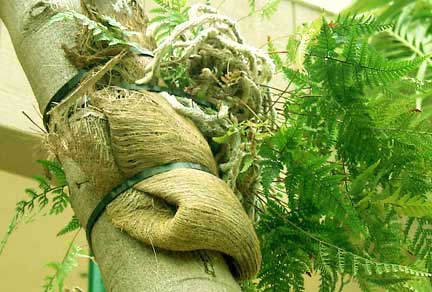
Giving your Garden the Tropical Look with Epiphytes

The lushness of a tropical garden can be greatly enhanced through the use of epiphytes. These nonparasitic tree-dwelling species are members of many different plant families and can be found flourishing under most climatic situations.
From wet rain forests to dry deciduous forests, orchids, bromeliads, and ferns are well represented in the canopies and on the trunks of tropical trees. Many other plant families also have epiphytic members. The Gesneriaceae (African Violet family), Cycadaceae (Cycads), Rubiaceae (including many species of ant plants), Cactaceae (Christmas cactus) and the Araceae (Philodendron family) are some of the more uncommon species found growing in trees.
Epiphytes are often thought to be parasites of their "host" tree. Mistletoes are the only epiphytes that are fully documented as true parasites (having roots that penetrate the tree's vascular tissue in order to receive nutrients). However, Live Oaks (Quercus virginiana) in central Florida that have heavy growth of Spanish Moss, and trees in the tropics that support large populations of orchids have been known to occasionally decline in health (although this is uncommon and needs further study and documentation). Planting epiphytes on the branches of trees and on the trunks of palms will not cause problems on the trees in your garden, if attached properly.
Certain species of trees and palms seem to be better hosts than others. Trees with an open canopy that allow light to penetrate through are usually the best for planting epiphytes. Calabash (Crescentia sp.), Live Oak, and Citrus sp., are excellent hosts. Staghorn ferns (Platycerium sp.), for example, grow very well on the trunks of palms. Although some palms, like Royal palm (Roystonea sp.), with a large leaf sheath (the basal part of the leaf that wraps around the trunk of the palm) will sometimes "clean off" epiphytes when the leaf falls.
Attaching epiphytes can be done many ways. The best method for attachment is one that does not utilize nails or staples that pierce the trunk of the host tree. Palms, for example, have no cambium layer. They will never heal if the trunk is punctured and will always be susceptible to invasion by fungi or insects. Other trees will eventually heal over (they have a cambium layer), but staples should not be the first choice, because there is still a chance for insect or disease invasion while the trunk is healing. String or thin wire can be utilized to fasten an epiphyte but the best results are achieved by attatching the plant with Zip-ties. What ever is used, it must remain until the plant becomes established. This may appear unsightly due to the amount of string or wire needed to secure the plant, but if the epiphyte is completely immobile, roots will establish easily. If rain or wind can shake the plant, roots will have difficulty becoming established and the epiphyte may not survive. Cable staples can be used if necessary, but great care must be taken not to damage the stem of the epiphyte when hammered onto the trunk. The use of glue will only secure the tiniest of plants and, if the bark below the glue comes off, the epiphyte will not survive. Once the plant is naturally secured, remove the method of attatchment.
Epiphytes derive most of their nutrients from the atmosphere. Depending on the species, their leaves and roots have specialized cells which absorb nutrients and moisture. The roots of epiphytes will also benefit from decomposed matter. To promote rapid growth, frequent watering and fertilizing should occur. Fertilizing should be done with a foliar spray, usually at half strength and watering should take into account the native habitat of the epiphyte (is it from a cloud forest with a daily immersion of fog or from a deciduous forest with a pronounced dry season?). Some bromeliads store water in their cups so their watering should be less frequent. Bird's nest Anthuriums and Aspleniums will accumulate leaves and other debris in the center of the plant and this can cause rotting due to excess moisture. Orchids with pseudobulbs store water and will not need to be watered as often as orchids without pseudobulbs. Knowledge of the epiphytes native habitat and an attempt to duplicate those conditions will usually ensure the success of their cultivation.





 About Tropical Plants
About Tropical Plants Giving your Garden the Tropical Look with Epiphytes
Giving your Garden the Tropical Look with Epiphytes Exotic Plants for Butterfly Gardens
Exotic Plants for Butterfly Gardens Canna Lilies for South Florida
Canna Lilies for South Florida